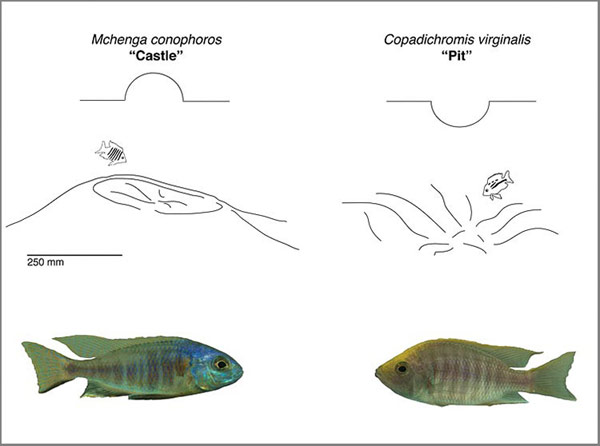
Screenshot from video courtesy Fernald Lab: Stanford biologists show how the evolution of physical traits can influence behavior in African cichlid fish.
Stanford Report - March 18th, 2015 - by Bjorn Carey
For many male African cichlid fish, the best way to attract a mate is to build a really nice pit or sand castle on a lake bottom.
And thus the best way to study evolution's effect on behavior might be to study why the fish build these structures, known collectively as bowers. New research by Stanford biologists reveals that multiple physical traits that arose in parallel heavily influence the fish's mating behavior of choice.
The research provides a potential framework for understanding how diverse molecular and physiological evolutionary adaptations can influence a species' behavior, and is detailed in the current issue of the journal Frontiers in Ecology and Evolution.
The evolution of behavior is notoriously difficult to study for a number of reasons, but the incredibly rapid speciation of cichlid fish in Lake Malawi in Africa makes them a prime candidate for investigation. More than 500 species of this family evolved in just the past 5 million years, one of the fastest rates among all vertebrates. And although these fish display a wide array of physical variation and traits, their genetic background is nearly identical, with just 0.26 percent variation across the species.
"You might imagine that the genome is a big box of parts that can be put together in many different ways to produce a fish that makes a bower shaped like a castle or a pit," said Russell Fernald, a professor of biology and senior author on the study. "Evolution is a puzzle. It's complicated and selection acts on many traits simultaneously. All these species share a toolkit that they assemble in different ways."

Image courtesy Ryan York/Fernald Lab: Evolution of specific physical
trains have led Mchenga conophoros to build castles to attract mates,
while Copadichromis virginalis builds pits.
Interestingly, the bower-building behavior is present in numerous, and varied, species, suggesting that the inclination to build castles or dig pits as a way to attract mates is the result of parallel evolution. Similarly, other traits have emerged across these species over time, such as specific jaw morphologies and retinal variations that improve vision in certain conditions.
Fernald and his colleagues speculated that these physical traits, which were driven by natural selection, might have influenced the emergence of the different bower-building behaviors, which are primarily driven by sexual selection. To find a connection, they sleuthed through multiple data sets of field observations and began examining several species of cichlids and recording their behavior.
They started by measuring differences in the fishes' jaws. The species that ate primarily plankton had adapted longer upper jaws that could open and close more quickly in order to catch their prey. Plankton is fairly transparent in shallow water, and so these fish have also evolved photoreceptors in their retinas that make it easier to see ultraviolet light shimmering off plankton.
Combined, these traits steer the fish toward building a certain type of bower, said Ryan York, a graduate student in Fernald's lab and lead author on the study
"If a fish sees higher levels of contrast, we found that it also has a higher tendency to build a castle, which casts shadows," said York, who is a Stanford Bio-X graduate fellow. "At the same time, we've found that these fish often have a jaw structure that makes it easier to manipulate sand, and so these evolutionary traits are probably driving this expression of mating behavior."
The researchers view this work as a proof of principle showing that modern molecular and physiology research methods and techniques could allow a greater understanding of social behaviors.
"If we find that certain genes drive this, we would see patterns in the part of the brain changes that leads to bower type," York said. "This might lead us to understand general principles about what type of biology is being selected for and how behavior plays a larger role in natural selection."
Echi Anoruo from Fernald's lab at Stanford also contributed to the study, which was coauthored by Todd Streelman and Chinar Patil at Georgia Institute of Technology, and with Darrin Hulsey at the University of Tennessee, Knoxville.


